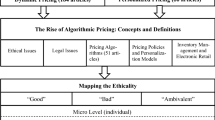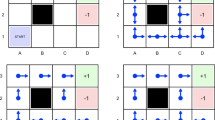Abstract
In this paper we study the optimal dividend problem where the surplus process of an insurance company is modeled by a Cramér–Lundberg model. As distinguished from classical models, we assume that the insurer can continue doing business although the surplus becomes negative, but penalty payments occur, depending on the level of the surplus. The higher the surplus level, the lower the penalty payments. The penalty payments are rather technical and necessary to avoid that losses can rise above any number. Nevertheless, the concept can also be reasonable in practice. For example, penalty payments can occur if the insurer needs to borrow money. The aim is to determine a dividend strategy that maximizes the difference between the expected discounted dividend and penalty payments. We show that the optimal strategy is a barrier strategy. As examples, exponential and linear penalty payments are considered.


Similar content being viewed by others
References
Albrecher H, Gerber HU, Shiu SW (2011) The optimal dividend barrier in the Gamma–Omega model. Eur Actuar J 1:43–55
Avanzi B (2009) Strategies for dividend distribution: a review. N Am Actuar J 13:217251
Azcue P, Muler N (2014) Stochastic optimization in insurance. A dynamic programming approach. Springer, New York
Brémaud P (1981) Point processes and queues. Springer, New York
Bühlmann H (1970) Mathematical methods in risk theory. Springer, Berlin
de Finetti B (1957) Su un’ impostazione alternativa della teoria collettiva del rischio. Trans XVth Int Cong Actuar 2:433–443
Gerber HU (1969) Entscheidungskriterien für den zusammengesetzten Poisson-Prozess. Schweiz Verein Versicherungsmath Mitt 69:185–228
Hipp C, Plum M (2000) Optimal investment for insurers. Insur Math Econ 27:215–228
Kulenko N, Schmidli H (2008) Optimal dividend strategies in a Cramér–Lundberg model with capital injections. Insur Math Econ 43:270–278
Marciniak E, Palmowski Z (2016) On the optimal dividend problem for insurance risk models with surplus-dependent premiums. J Opt Theor Appl 168:723–742
Scheer N (2011) Optimal stochastic control of dividends and capital injections. Dissertation, University of Cologne
Schmidli H (2002) On minimising the ruin probability by investment and reinsurance. Ann Appl Probab 12:890–907
Schmidli H (2008) Stochastic control in insurance. Springer, London
Vierkötter M, Schmidli H (2016) On optimal dividends with linear and exponential penalty payments. Insur Math Econ 72:265–270
Vierkötter M (2016) Minimisation of penalty payments by investments and reinsurance. Eur Actuar J 6:233–255
Author information
Authors and Affiliations
Corresponding author
Rights and permissions
About this article
Cite this article
Vierkötter, M. On optimal dividends with penalty payments in the Cramér–Lundberg model. Eur. Actuar. J. 7, 535–552 (2017). https://doi.org/10.1007/s13385-017-0153-3
Received:
Revised:
Accepted:
Published:
Issue Date:
DOI: https://doi.org/10.1007/s13385-017-0153-3




